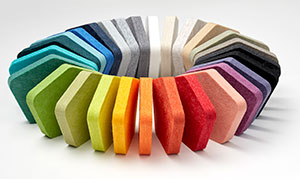Building with recycled plastics
Building with recycled plastics
<
RT: Could you share some details about the EchoPanel product?
JS: EchoPanel is a collection of decorative acoustic panels, tiles, and wall and ceiling systems with a felt-like finish that help absorb sound in enclosed spaces, therefore reducing acoustic distraction. About seven years ago, I began hearing from designers that they needed acoustic solutions to the new problems created by open-office and open-design style had become so popular. I found EchoPanel, which had been on the market in Asia and Australia, but not here in the U.S. At the time, acoustic design materials generally did not have much aesthetic property, so the ability to have color and design flexibility was a real plus with EchoPanel—along with the recycled content and zero VOC nature of the material itself.
The product’s range of options in terms of thickness, color, pattern and form allows for a high level of customization. EchoPanel is made from recycled plastic bottles and is recyclable after use. To date, over 107 million plastic bottles have been saved from landfills and turned into EchoPanel products. The EchoPanel collection comes in neutral and vibrant colors, plus standard or custom design options to fit a variety of spaces and décor needs. EchoPanel is manufactured in Australia by Woven Image and distributed exclusively in North America by Kirei. Additionally, using EchoPanel can help commercial design projects qualify for LEED and other green building certifications for low VOC, healthy spaces and recycled content.
RT: Has EchoPanel always used recycled PET content? What percentage of the PET in the EchoPanel is postconsumer?
JS: Yes. As acoustic design has become essential to great space design, the old standards of acoustic treatment—such as carpeted walls or drab fabric-wrapped panels—no longer cut it. PET felt has leapt into the spotlight as the ‘go-to’ material that absorbs sound while offering a new palette for both visual and acoustic design. Approximately 60 percent of the PET is postconsumer. The PET is sourced from worldwide recycling programs.
RT: How does having recycled PET help enhance the product? Why did you go that route with this product?
JS: Durable in nature, PET felt offers great acoustic performance and can be recycled at the end of its life. Most importantly, recycled PET helps our customers fulfill their desire to use earth-friendly, resource-friendly products. This aligns with the DNA of Kirei, which is looking to provide great-looking, functional [and] sustainable products.
RT: Did using recycled plastics create any challenges to the design of this product? If so, what were those?
JS: Recycled plastic has a different melting point than virgin PET, so experimentation was necessary to get optimized performance and a consistent product.
]]>
Source: Recycling Today
Building with recycled plastics
<
